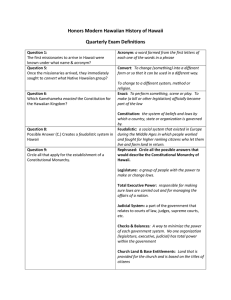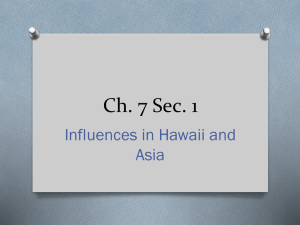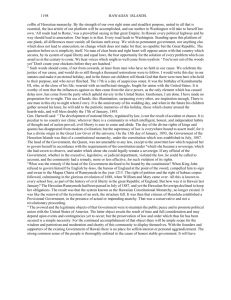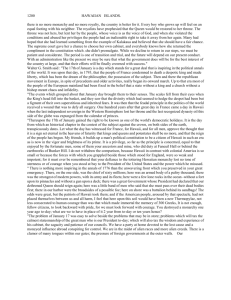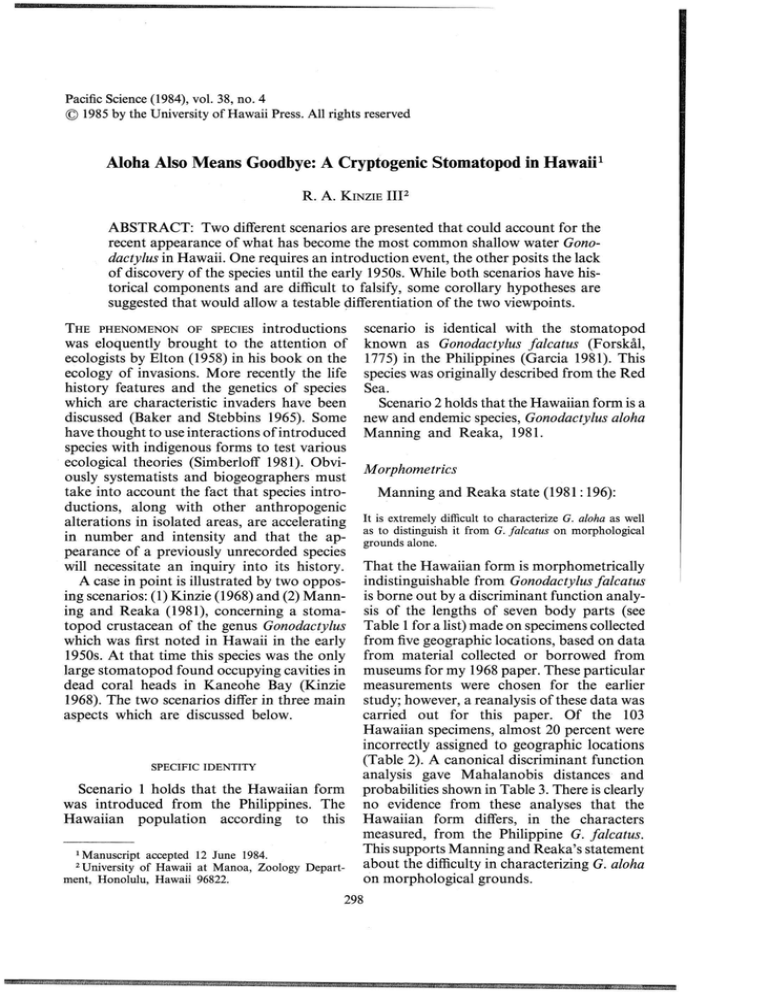
Pacific Science (1984), vol. 38, no. 4
© 1985 by the University of Hawaii Press. All rights reserved
Aloha Also Means Goodbye: A Cryptogenic Stomatopod in Hawaii 1
R. A. KINZIE lIP
ABSTRACT: Two different scenarios are presented that could account for the
recent appearance of what has become the most common shallow water Gonodactylus in Hawaii. One requires an introduction event, the other posits the lack
of discovery of the species until the early 1950s. While both scenarios have historical components and are difficult to falsify, some corollary hypotheses are
suggested that would allow a testable differentia tion of the two viewpoints.
THE PHENOMENON OF SPECIES introductions
was eloquently brought to the attention of
ecologists by Elton (1958) in his book on the
ecology of invasions. More recently the life
history features and the genetics of species
which are characteristic invaders have been
discussed (Baker and Stebbins 1965). Some
have thought to use interactions ofintroduced
species with indigenous forms to test various
ecological theories (Simberloff 1981). Obviously systematists and biogeographers must
take into account the fact that species introductions, along with other anthropogenic
alterations in isolated areas , are accelerating
in number and intensity and that the appearance of a previou sly unrecorded species
will necessitate an inquiry into its history.
A case in point is illustrated by two opposing scenarios: (1) Kinzie (1968) and (2) Manning and Reaka (1981), concerning a stomatopod crustacean of the genus Gonodactylus
which was first noted in Hawaii in the early
1950s. At that time this species was the only
large stomatopod found occupying cavities in
dead coral heads in Kaneohe Bay (Kinzie
1968). The two scenarios differ in three main
aspects which are discussed below.
SPECIFIC IDENTITY
Scenario I holds that the Hawaiian form
was introduced from the Philippines. The
Hawaiian population according to this
Manu script accepted 12 June 1984.
University of Hawaii at Manoa, Zoology Department, Honolulu, Hawaii 96822.
1
2
scenario is identical with the stomatopod
known as Gonodactylus falcatus (Forskal,
1775) in the Philippines (Garcia 1981). This
species was originally described from the Red
Sea.
Scenario 2 holds that the Hawaiian form is a
new and endemic species, Gonodactylus aloha
Manning and Reaka, 1981 .
Morphometries
Manning and Reaka state (1981 : 196):
It is extremely difficult to characterize G. aloha as well
as to distinguish it from G. faleatus on morphological
grounds alone.
That the Hawaiian form is morphometrically
indistinguishable from Gonodactylus falcatus
is borne out by a discriminant function analysis of the lengths of seven body parts (see
Table I for a list) made on specimens collected
from five geographic locations, based on data
from material collected or borrowed from
museums for my 1968 paper. These particular
mea surements were chosen for the earlier
study; however, a reanalysis of these data was
carried out for this paper. Of the 103
Hawaiian specimens, almost 20 percent were
incorrectly assigned to geographic locations
(Table 2). A canonical discriminant function
analysis gave Mahalanobis distances and
probabilities shown in Table 3. There is clearly
no evidence from these analyses that the
Hawaiian form differs, in the characters
measured, from the Philippine G. falcatus.
This supports Manning and Reaka 's statement
about the difficulty in characterizing G. aloha
on morphological grounds.
298
TABLE
M EANS
( ± I S.D .)
CARAPACE
LENGTH
=
103)
H awa ii (N
Lord H owe I sland (N
Philippines (N
12)
Queensl and (N
46)
=
=
Red S ea
(N
= 41)
= 50)
9.25 ±
12.91 ±
8.20 ±
9.09 ±
10.58 ±
3.20
2.73
3.37
3.01
2.76
I
FOR TH E S EVEN B ODY PARTS WHI CH W ERE M EASURED FOR THE ANALYSIS IN T ABLE
PROPODUS
LENGTH
6.79 ±
9.40 ±
6.00 ±
6.66 ±
7.99 ±
2.41
1.97
2.42
2.18
1.93
ROSTR UM
WIDTH
2.69 ±
3.65 ±
2.66 ±
2.6 1 ±
2.96 ±
0.77
0.59
0.86
0.71
0.56
TELSON
WIDTH
5.69 ± 1.99
8.66 ± 1.72
5.18 ±2.11
5.87 ± 1.90
6.69 ± 1.60
DACTYLUS
LENGTH
6.41 ±
8.94 ±
5.69 ±
6.38 ±
7.50 ±
2.26
1.90
2.29
2.10
1.74
2
TELSON
LENGTH
5.77 ±
8.34 ±
5.36 ±
5.71 ±
6.81 ±
1.94
1.65
2.12
1.72
1.66
ROSTRUM
LENGTH
2.66 ± 0.64
3.40 ± 0.46
2.65 ± 0.83
2.64 ± 0.58
2.92 ± 0.46
PACIFIC SCIENCE, Volume 38, October 1984
300
TABL E 2
P ERCENTAGE OF
103
SP ECIMENS OF H AWAIIAN
Gonodactylus ASSIGNED TO
F IVE G EOG RAPHIC L OCATIONS
FROM WHICH C OLLECTIONS W ERE A VAILABLE*
LOCATIO N
Hawaii
Queensland
Red Sea
Lord Howe Is.
Philippines
PERCENTAGE
81.55
2.9 1
9.71
1.94
3.88
• Discrimina nt function ana lysis SPSS. Prior probabilities set
equal to sample size. Almost 20% of the Ha waiian specimens were
incorr ectly assigned.
In their discussion , Manning and Reaka
(1981 : 196) suggest some other morphometric
features that may differ between Gonodactylus
falcatus and G. aloha:
(a) Rostral plate usually broader than long
in Gonodactylus falcatus but usually longer
than broad in G. aloha. The specimens from
the Red Sea agreed with their characterization
of G. falcatus with 63 percent having rostral
length : breadth ratios less than one. The
Hawaiian form had length : breadth ratios
greater than one in 52 percent of the specimens, which is also in agreement with the
characterization of Manning and Reaka.
The Philippine specimens were similar to
the Hawaiian ones in that they had
length : breadth ratios greater than one in 64
percent of the specimens . However, in none of
t~ese collections are the ratios significantly
different from 50: 50 (chi square test
IX = .05).
(b) Telson usually about as broad as long in
Gonodactylus falcatus but usually broader
than long in the Hawaiian form. The specimens from the Red Sea differed significantly
from a 50 : 50 ratio with 60 percent of the individuals having telsons that were longer than
broad. This was also true for 70 percent of the
~awaiiat.t specimens which were highly significantly different from a 50 : 50 ratio, and in a
?irection opposite to that suggested by Mannmg and Reaka. The specimens from the Philippines had 64 percent of the specimens with
telson length: breadth ratios greaterthan one,
but this collection did not differ significantly
from a 50: 50 ratio.
.
At any rate the use of ratios can cause further ~nalytical problems (see Atchley 1978),
especially as the relative proportions of some
body parts vary with age in stomatopods.
Color
Manning & Reaka (1981: 196) state that
color is an important diagnostic character:
More con vincing evidence of the distinctness of the Red
Sea a nd Hawaii an populations previously identified with
G.falcatus lies in the color in life of specimens from the
two areas .
While Manning and Reaka list several color
differences, they apparently failed to use any
sort of color standards (e.g., Wilson 1941), so
the usefulness of their extensive discussion of
color is que~tionable. While they ma y, in fact,
be able to differentiate specimens from different areas, the utility of this character in defining the species, as well as its usefulness to
other workers, is of little value.
In order to test the applicability of such subjective color judgments, an experiment was
performed using living specimens of Gonodactylus from Kaneohe Bay, the type locality of
G. aloha. These animals were collected in 1983
for this study. Twelve graduate students with
no knowledge of the Manning and Reaka
paper or of the colors associated with the Red
Sea and Hawaiian forms were asked to name
the color of six body parts selected from
Manning and Reaka as being most diagnostic
of the differences between the two forms. The
wide range of variability between individual
observers and between different specimens
makes unequivocal assessment of the color
patterns difficult. The results are shown in
Table 4. Clearly , such subjective color evaluatio~s are useless in establishing a new species.
With regard to differentiating between the
two s~~narios a c~mparison between living
Hawauan and Philippine forms would of
course be the most appropriate, but this was
not possible .
Larvae
Manning and Reaka (1981: 197) suggest
that differences between larval stages may
differentiate the two forms:
A Cryptogenic Stom atopod in Hawaii-Kinzie
30 1
TABLE 3
MATRIXOF MAHALANOBIS DISTANCES AND ASSOCIATED PROBABILITIES OF DISTANCES FOR THE FIVE COLLECTIONS·
HAWAII
Ha waii
Lord Howe Is.
Philipp ines
Queensland
Red Sea
LORDHOWE IS.
0.00
3.492
1.732
1.542
1.331
3.32 1
2.653
3. 128
PHILIPPINES
QUEENSLAND
RED SEA
.8 163
.00 1
.000 1
.0000
.0000
.0065
.0000
.0000
.0000
2.467
2.394
1.505
* Can onical discrim inant function an alysis SAS. Values below diagonal are Mah alanob is dista nces between samples. Va lues
above diagonal a re the associated proba bilities. The analysis suggests that the Hawaiian and the Philippine collections cannot be
differentiated.
Such differences between the same lar val stage from two
different region s seem to us to be of far greater magnitud e
than might be attributa ble to varia tion within a species.
Mann ing and Reaka (1981: 196) use five
differences between Hawaiian (da ta from an
unpublished report of mine and specimens
supplied to R . B. Manning) and Red Sea
(Gohar and AI-Kholy 1957) stage V larvae as
" additional evidence, although incomplete,
that the Hawaiian and Red Sea populations
represent distinct species."
I . Ro strum exceeds antennules in the Red
Sea specimens but not in the Hawaiian
specimens .
2. Ro strum with five ventral spines in the
Red Sea larvae, but with four in the
Hawaiian form .
3. Posterolateral spines of the carapace
extend to the middle of the fifth abdominal somite in the Red Sea lar vae
but not beyond the second abdominal
somite in those from Hawaii.
4. Antennal scale with 12 marginal setae in
Red Sea larvae and with 14setae in tho se
from Hawaii.
5. Art iculation of the sixth abdominal
somite with the telson is complete in larvae from the Red Sea but no t in the
Hawaiian larvae.
There are several problems with the an alysis of larval characters given by Manning and
Reaka. Comparisons using mass reared lar vae
(as were tho se studied by Gohar and AIKholy 1957) ma y be misleading since larval
stages may be missed or misidentified (Williams 1982). Certainly differences in charac-
ters of lar vae reared under different con ditions at different location s should not be
given too much significance since inconsistencies in rearing methods, temperature, food ,
and so on can all cau se modi fications in the
development, timing , and recognition of
larval stages (see Reese and Kinzie 1968 for
some examples). Furthermore, fixation may
cause swelling and thus obscure real
differences or similarities in the length of body
parts (see Manning and Provenzano 1963).
With regard to the specific points made by
Manning and Reaka: Points 2 and 4 refer to
the number of rostral spines and marginal
setae of the antennal scale respecti vely. The
ranges in these counts from two studie s conducted by two different workers using very
different rearing conditions is less th an or
equal to the range for the same body parts of
Gonodactylus oerstedii lar vae in a single experiment from the same population (Provenzano and Manning 1978, table 3). This clearly
contradicts Manning and Reaka's statement
(1981: 197): "variation of that magnitude was
not seen in larvae of that [G. oerstedii]
species." Clearly such small meristic
differences should not be used to split one
species while being considered part of the
normal range of variation in another.
Points I and 3 could well be problems of
fixation or proper iden tification oflarval stage
(see above ).
With regard to point 5, Provenzano and
Manning (1978, table 3) indicate that the completene ss of the articulation of the sixth ab dominal somite in the Red Sea form is
que stionable.
TABLE4
C OLORS OF THE S IX B ODY PARTS USED BY MANNI NG AND R EAKA
(1981) TO
DIF FERENTIATE
Gonodactylusfalcatus FROM G. aloha
DISTAL
WALKING '
ANTENNAL
ENDOFOD
UROPOD
POSTERIOR LINING
PROMIN ENCE*
LEGS
SCALE
OF UROPOD
OVERALL
OF ABDOMINAL SOMITE
blue or blue-green
crim son,setae
red
MALES
G.jiJ1calus
I
2
3
4
5
6
7
8
9
10
II
12
G. aloha
brown
red
V
gr- pr
dkr/pr
bk
bk
br/bk
bk
bk
br/bk
bkfbr
bk
bk
bk
pk /gr
bl-gr
rIm
pr/pk
1
pk/l
. pk/r
r- br /v
vl»
o/pk
pk
o/pr
bl or bl-br
or bl-br
scarlet proximally
blue distally
c1
gr/bl
br /gr /pk
gr
bl-gr/pk
r- br/gr
pk-br(y- gr
r/gr
gr
o- gr
r-bl
y-pk
m pro ximally
It- bl distally
crimson or
scarlet
pr
bl-gr
r
bl/t
bl/bl-gr
gr
gr/bl
r/gr
pk/l
grIt
pr-pk
bl- gr
p-o basically
y distally
pr
r
gr/r
pkjpr
J:
pk/r
r/bl'- gr
gr/r
pk/l
o/t
pk-gr/bl
pk-o
no bl
t
br/dkr-br
r-Y /m
y-brjbr
1
br
br /dk gr
br /r- br
br
br/dk -gr
y-grflt- gr
gr/d k- gr
red
II
,t
FEMALES
Gcf alcatus
brown
yellow
brownish proximally
yellow distally
yellow w/
crimson setae
(no t given )
red
I'
v
r-br
br
br
It- br
2
3
4
r
o/br
brio
gr
bl- gr
gr
gr
r- o/gr
gr
br- gr
pk
r--br
o-gr
pk /o
0
0
0
0
r
r-br
o- r
o/r
pk
o- gr
o/gr
gr /br
y- gr
o/y
o/y
o/y
o/y
o-y
r/y
gr
9
10
11
dk- br/ bk
br/bk
br
g
bk
bk
dk- br/ v
br- bk
br -bk
r - bk
12
bk
bl/pr
y- pkjo
bl- gr
pk/r
br
br /dk- gr
dk- o/dk- br
br
b/bk -br
sa me as rest
of somite
gr/dk- gr
y or y - gr
(merus onl y)
m pro ximally
p/o th an y
distally
p- o basically
y distall y
no bl
5
6
7
8
G. aloha
bl- gr
0
o]:
0
r - gr
gr/ r
o- r
gr/br
pk/y
same as rest
of so mite
r-br/dk -br
bk/o
not red
N OTE: At the head of each part of the tab le is the color of the ta bled bod y part for Gifalcatus, then follow color evaluatio ns made by 12 observers. At the bott om of each part is the co lor
diagnostic of G. aloha. A dash (- ) indicates an intermediate color , a slash (/) indicates differences between specimens. r = red, br = brown, sc = sca rlet, y = yellow, bl = blue, bk = black,
gr = green, 0 = orange, pk = pink, pr = purple, I = la vender, t = tu rqu oise, g = grey, m = maroon , bg = bluegreen, dk = dark, It = light, v = violet, cl = clear , t = tan .
• Manning a nd Rea ka 1981 : 196.
=
304
PACIFIC SCIENCE, Volume 38, October 1984
Point 3 seems to be the mo st pronounced
difference between the Red Sea and the
Hawaiian larvae. Gohar and Al-Kholy's
figures depict larvae of all planktonic stages
(IV thru "VI") with long carapace spines rela tive to those of the Hawaiian form . Pro venzano and Manning state (1978 : 309): "The excessive length of the carapace spines in Gohar
and AI-Kholy's sta ge VI lar vae was not
matched in Gurney's [1937] stage VI also from
the Red Sea, in Kinzie's larvae from Hawaii
or in our lar vae of G. oers tedii:"
Caution should be used in making the com parison of stage V lar vae from the Red Sea
and those from Hawaii because the stage V
larvae of Gohar and AI-Kholy appeared 21 d
after hatching while the stage V Hawaiian larvae ran from day II through day 16. This
period overlaps stages III and IV of Gohar
and AI-Kholy. The Hawaiian lar vae reached
sta ge VI by da y 16 when the Red Sea larvae
were still in stage IV. These differences in tim ing and length of carapace spines could be due
to real differences in the larval stocks as suggested by Manning and Reaka but could equ al1y wel1 be due to the very different rearing
conditions (see William s 1982). Perhap s it is
best to follow the caution of Provenzano and
Manning (1978: 309) in their discussion of the
later stage VI larvae: "The apparent differences betw een Kin zie's specimens and tho se
from the Red Sea indicate that direct comparisons based on published works are
unreli able ."
Taking into account the adult morphological and color characters and the lar val descriptions, there is littl e in Manning and
Reaka to support the con tention that the
Ha waiian form is different from Gonodactylu s
falcatus and nothing at al1 that addresses the
Philippine-Hawaiian connection set out in
scenario I.
HISTORY OF THE FORM IN HAWAII
Scenario I holds tha t the Hawaiian form is
an introduced specialist species th at repl aced
an indi genous generalist, Pseudosquilla ciliata
(F abricius, 1787), from part of the latter's
habitat -the dead bases of corals and dead
corals.
Scenario 2 holds that the H awaiian form is
nati ve to Hawaii and th at it is the habitat
which is new. This scenario holds that dead
corals have significantly incre ased in abundance in K aneohe Bay.
The Existence of Dead Corals in H awaii
The suggestion that dead co ral s were not
common on Hawaiian reefs until the 1950s
seems a peculiar assumption for anyone familiar with coral reefs an ywhere in the world.
Th e fact th at not onl y were dead corals
common in Kaneohe Bay, but that patch reefs
with tops of dead corals-the typical Gonodactylus hab itat in Kaneohe Bay- were present in the earl y part of this century, is clear
from earl y accounts of the bay. Writing of
L eptastrea MacKaye (1915) states: " It spreads
over the surfaces of other va rieties of dead
corals on both the inner and outer reefs," and
of Favia: " It forms rather large colonies by
spreading over the dead colonies of other
species." MacKa ye (1916) also describes a trip
in a glass-bottom bo at in Kaneohe Bay: " And
here we come to the second reef, one which is
partly dead on one side but alive on the other."
Photographs as early as 1928 show the typical
patch reef environments in Kaneohe Bay (D evaney et al. 1982).
La ck of Se arching in the Dead Coral
Habitat
It might be maintained that although the
dead coral habitat existed in sufficient abundance to support the endemic stomatopod,
the animal remained unnoticed until the
1950s.
It is difficult to support this contention in
view of the exten sive col1ections and publication s of C. H. Edmondson who began his research in Hawaii in 1920 (Banner 1977). Edmondson was a typical biologist of his .day,
rarel y working deeper th an the shallow subtidal except with a dredge. Primarily a specialist in decapod crustaceans, he made exhaustive collections in dead and living coral heads
in the intertidal and shallow subtidal (A. H .
Banner, pers . comm.), as evidenced by the
fol1o wing:
f'Imtll"''''''
305
A Cryptogenic Stomatopod in Hawaii-Kinzie
Man y [xanthid cra bs] seem to be dispersed without reference to any particular environment within a given area,
wandering at ran dom seeking concealment und er sto nes
or in crevices of dead coral heads. (Ed mondson
1962 : 2 16)
Type locality Waikiki reef Oahu in shallow water in a
dead coral colony. . .. (Ed mondso n 1930:7)
Type locality, island of Maui , collected by Mr s. F. K.
Skinner in shallow water among dead coral heads. .. .
(Edmo ndso n 1930: 7)
Blocks of dead coral when broken into pieces, may yield
some of the more unusual forms of swimming cra bs which
hide in the crevices of coral. (Edmondso n 1959 : 154)
As a carcinologist, Edmondson was not
likely to miss such a large , conspicuou s member of the faun a. Edmondson cert ainly did
collect other stomatopods (Edmondson 1923,
Edmondson et al. 1925), and he was clearl y
aware of the occu rren ce of Pseudosquilla
ciliata which he termed " The mo st common
species about local shore s [it] is found in shallow water under sto nes or in holes in dead
cora l blocks " (Edmondson 1933: 208). Edmondson also described a very small stomatopod (Coronida sinuosa Edmondson 1921 )
less than 20 mm long from Ha waii.
In addition to the exten sive work of Edmondson, the Banners began their intensive
work on alpheid shrimps, common inhabitants of dead coral heads, in 1937. While
countless dead coral head s were broken open
in search of the alpheid shrimps, no gonodactylid stomatopods the size of Gonodactylus
falc atus were ever seen (A. H .Banner, pers .
comm.).
In addition to the work of the se carcinologists in Hawaii, S. J. To wnsley in 1948 began
his research , which focused specifically on
stomatopods. Although he found stomatopods as inconspicuous as Coronida sinuosa,
the only large stomatopods he found in dead
cor al in sha llow water were Pseudosquilla
ciliata and P. oculata (Brulle 1836) (Townsle y
1953and pers. comm.). The comparison of the
well-studied cor al head habitat and th at of the
anchialine ponds in Hawaii (Manning and
Reak a 1981: 199) is totally misleading since
the latter habitats had not been examined
until the 1970s (Maciolek and Brock 1974).
Thus neither the contention that the habit at
was not abundant nor that it was insufficiently
......
~
- -._...............
searched can be suppor ted. While negative
evidence such as th is can never unequivocably
establish the fact that the stomatopod was trul y
ab sent , the weight of the data indicates that
the burden of proof lies on supporters of the
second scenar io. Th at is, since dead cora ls
were a common habitat element in Kaneohe
Bay for many years before the appeara nce of
the species, some explanation for its apparent
ab sence must be put forth . .
Pseudosquilla ciliata
Gonodactylus
REPLACEM ENT OF
BY
Scenario 1 hold s th at the more aggressive
coral cavity specialist, Gonodactylus, competitively displaced the habi tat generali st, Pseudosquilla ciliata, from th e dead coral habit at.
Scenario 2 hold s that th ere was no competitive
displacement ; rather, Gonodactylus aloha
simply moved into a habitat th at had increased in availability (Manning and Reaka
1981 : 199).
To support their scena rio Manning and
Reaka make three points from a dissertation
by Hatziolo s (1979):
1. In a field experiment Pseudosquilla
ciliata did not mo ve into suitable cavities
which were experim entall y provided.
2. Add itions of burrows to a study site did
not increase the density of P. ciliata.
3. When Gonodactylus is less th an 80 percent of the size of Pseudosquilla, the latter
dominates the interactions.
From th ese points Manning and Reak a
(1981: 197) conclude:
(A ) that cora l rubble is not the primary preferred habitat
of P. cilia/a.
This appears to be a straw man that has nothing to do with the fact tha t P. ciliata did in
fact occupy cor al head rubble in Hawaii until
the 1950s (Edmondson 1933, Townsley 1953).
Scenario 1 says nothing about coral rubble
being " the primary preferred habitat of P.
ciliata." Both Kin zie and Hatziolo s state explicitly tha t P. ciliata is a generali st:
306
Its [Po ciliata] occurrence in hard and soft substrates, in
cavities of co ral rubble or U-shaped bu rro ws it fashions
out of sediment a nd algae, furth er qu alify it as a generalist. (Ha tziolos 1979: 13)
Since P. ciliata can be found in burro ws in mudd y bottoms an d walk ing freely on the bott om, and since, prior to
1953 it was tak en from coral head s, th is species seems to
have a wider range of po ssible habitats th an does Gonodacty lus falca tus. (Ki nzie 1968 :473 )
But as Hatziolos (1979: 17) also states, other
things being equal P. ciliata will tend to
occupy dead coral: " P . ciliata prefers the less
vulnerable coral cavities as shelters when
available."
The second conclusion made by Manning
and Reaka (1981 : 197) is:
(B) Th e availability of burrows (or inavail ability [sic] as
the result of their occupat ion by Gonodactylu s) does
not regulate population densities of P. ciliata.
Like point (A) this is a straw man since there
was no statement in Kinzie (1968) that the introduction of Gonoda cty lus regulated the
population density of P . ciliata. In fact I stated
(Kinzie 1968:474): " It can be further predicted that the presence of G. falcat us in
Hawaii will not affect those populations of
Pseudosqui//a ciliata utilizing habitats other
than coral heads. " However, it is interesting
that Hatziolos (1979) states:
Th e agonistic coil [intense mutual escalation] is frequentl y
ob served among Hawaiian indi vidual s [of P. ciliata] mo st
ofte n assoc iated with burrow defense; (p. 117)
Under conditions of extr eme enviro nmental rigor , such
as, for example, when the ratio of population to resource
density is high, agg ressive behavi or may reach its full potent ial; (p. 118)
The fact that intense escalation during bu rrow defense
occur red more frequently in Hawaii than in Jam aica suggests th at the pa yoff in fitness gain from burrow acquisitio n may be much higher in the fo rmer site. (p. 120).
It appears from Hatziolos' dissertation that
at the time she was doing her research in
Hawaii, there was markedly more intraspecific
competition for burrows among Ha waiian
Pseudo squi//a ciliata than in Jamaica: It would
be impos sible at this time to determine if this
pressure was due to the activities of P. ciliata
individuals evicted by Gon oda ctylus, or to
other factors. At any rate Manning and
PACIFIC SCIENCE, Volume 38, October 1984
Reaka's conclusions (A and B) neither refer to
necessary components of Scenario I, nor are
they actually supported by the data they cite
from Hatziolos. Their third conclusion is:
(C) th at P. ciliata frequ ently may dominate G. aloha
beh aviorall y du e to the larger body size of the forme r.
(Ma nning and Reak a 1981: 198)
They go on to state that Hatziolos (1979: 120)
found that:
Am on g Hawaiian anima ls, P. .ciliata resident s succeeded
in defending th eir burrows against intruders in 95% of the
encounters indicating strong territoriality and willingn ess
to defend.
Manning and Reaka neglect to state that these
were intraspecific encounters and thu s irrelevant to the question of interspecific aggression.
In fact, Hatziolos (1979 : 112) states: " Without exception, Hawaii individuals [of P.
ciliata] inhabiting cavities in preference to
artificial burrows were evicted by intruding
Gonoda ctylus admitted to the tank." These
were size-match ed encounters. To support
their contention that P . ciliata ma y dominate
the Ha waiian Gonoda ctylus behaviorall y due
to the lar ge bod y size of the former, Manning
and Reaka refer to Hatziolos (p. 112and fig. 4,
p. 109) and conclude: "In contrast, when the
indi vidual Gonoda ctylus was less than 80% of
the size of its larger Pseudo squi//a opponent,
the latter dominated the interaction" (Manning and Reaka 1981: 197). Manning and
Reak a then state that since these data were obtained from Thailand where the P. ciliata are
less aggressive, their conclusion is conservative. They neglect to mention that the Gonodactylus species that Hatziolos studied in
Thailand were G. viridis and G. chiragra as
well as G. falcatus and were not treated
separately in her dissertation (Hatz iolos
1979: 110); so Manning and Reaka's conclusion is not conservative-it is invalid.
As a qualification of their statement about
the aggressive nature of Pseudosqu illa ciliata
Manning and Reaka (1981 : 198) state :
However, Cald well an d Dingle (1975 : 220) reported that
in lab or at ory experiments P. ciliata was always drive n
from a burrow (a glass vial) when G. falcatus was introduced into the same tank, but the reverse was never
observed .
A Cr yptogenic Stomato pod in Hawaii-Kinzie
In fact the information presented by Caldwell
and Dingle are from my earlier paper (Kinzie
1968, table 2) where, interestingly, in 50 percent of the winning encounters, the GonodactyIus individual was less than 80 percent of the
size of the losing P . ciliata . While my sample
sizes were not as large as those of Hatziolos,
these data should not be ignored.
Manning and Reaka present data showing
that in Hawaii Gonodactylus is 58-60 percent
the size of Pseudosquilla ciliata. No extensive
tests matching individuals of these relative
sizes have been made in Hawaii, nor has it
been shown that the largest P. ciliata can even
physically fit into crevices of the size inhabited
by the Hawaiian Gonoda ctylu s.
DISCUSSION
Both scenarios have historical components
that are untestable. In support of Scenario I it
could be argued that Hawaii has received and
is continuing to receive numerous exotics .
Lar ge numbers of this cru stacean [ a grapsid cra b] were
recovered from the fouling on the hull of a barge in Pearl
Harbor dry dock April 5, 1950.The barge served in Gu am
during World War II, but had been anchored in Pearl
Harbor for the past two years. Apparently this species has
not been recorded previously from the Hawai ian area .
The adults of this crab may have been transported from
Guam but the myriads of juvenile specimens obser ved
indicate that propagation of the species has taken place
since reaching Pearl Harbor. (Edmondson 1951:212)
Observation s in the local drydocks indicate that man y
exotic forms of marine life may be introduced into new
environs in this manner. How man y of them become
established under altered conditions it is impossibl e to
say, but there is evidence that some of them do . (Edmondson 1959 : 154)
Elton (1958 : 100) makes the point that oyster culture is " the greatest agency of all that
spreads marine animals." In 19~9, 210 cases of
Crassostrea gigas spat from Japan were sown
in Kaneohe Bay (Devaney et al. 1982 : 101). In
addition Kaneohe Bay has been sown with
Japanese little neck clams (Tapes japonica),
Japanese clams (Meretrix meretrix) , and
Australian oysters (Ostrea cuculata) (Devaney et al. 1982). The bait wells of commercial fishing boats are another source of accidental immigrants. Fishes from the South and
307
Central Pacific have been either introduced in
baitwells or accidentally mixed with inten tional introductions (Randall and Kanayama
1972). Introductions of oetocorals from the
Caribbean (Thomas 1979), sponges of the
fouling community (Bergquist 1967), marine
algae from the Philippines and elsewhere in
the Pacific (Russell 1981), and scyphozoans
from the Philippines (Cooke 1984) support
the idea that Hawaii is receiving many successful marine introductions.
It is interesting to note that Gonodactylus
hendersoni Manning, 1967, a much smaller
stomatopod, was also first noticed in Hawaii
about the same time that the large Gonodactylus was reported. I suggested (Kinzie
(1968 : 474) that "Gonodactylus falcatus and
G. hendersoni came to the Hawaiian Islands
from the area of the Philippines or the South
China Sea by means of concrete barges."
Nonetheless, it could always be argued (as one
reviewer of this paper did) that had Edmondson turned over one more stone or split one
more coral head the elusive G. aloha might
have been found .
Support for Scenario 2 might come from
the fact that new species are being described
from Hawaii , and this is evidence that some
species have simply gone unnoticed until now.
It has , however , been shown above that the
habitat of the Hawaiian Gonodactylus is not
pew, nor has that habitat gone unsearched. At
this point the two scenarios remain, each with
untestable historical components. Do any of
the three points discussed above suggest falsifiable hypotheses generated by either of the two
viewpoints?
Specific Identity
A cladistic analysis of the falcatus group of
Gonodactylus (Manning 1978) has not been
carried out. However, such an analysis could
differentiate between Scenario I , which predicts that the Hawaiian and Philippine forms
share an immediate common ancestor (Figure
lA) , and Scenario 2, which predicts a more
distant relationship (Figure IB). Should the
Hawaiian and a Philippine population in the
falcatus group prove to be the same or sister
groups, Scenario 1 would be supported. A
308
PACIFIC SCIENCE, Volume 38, October 1984
Ce n t r a l Pa cif i c fa l c at us
gro up St oma t o p o d s
Oth er memb er s o f f a lca t us g ro up
~
" " " , ", ,
"" " , " ,, ,
",
"" " " ,
"
"
"", , "" "",,
" ,
"" ",, " "
"" , "
", "
",
A
p
H
,,
H
P
,,
",
""
",
""
"" ,
"
"B
FIGURE I. Cladograms of the falcatus group of Gonodactylus as predicted by Scenar io I (A) where the Hawaiian
form (H) and the Philippine form (P) share an immediate common ancestor, and by Scenario 2 (B) where the Haw aiian
form is more closely related to Central Pacific form s. In A the two forms may in fact not be distin guishable . The position
and number of dotted lines represent unkn own relationships.
closer relationship of the Hawaiian popu- situation. The Philippine source population
lation to Pacific Basin species would be may represent a good species in the falcatus
evidence for Scenario 2. This is because much group (see Garcia 1981, who differentiates beof the native Hawaiian marine fauna is most tween Philippine G. falcatus and G. glabrous
closely allied with forms from the Pacific Brooke [1886]) but one distinct from the Red
Basin (Edmondson 1940, Gosline 1968) as de- Sea population (and also, as the evidence prelineated by the Pacific plate (cf. Springer sented here suggests, distinct from the south1982). There is a further interaction between ern hemisphere populations as well). This
biogeography and systematics in situations possibility was not addressed by Manning and
like the one described in this paper. Carlton Reaka. As to the specific identity of the
(1982) pointed out that the rapidly increasing Hawaiian form , it is unlikely that the concept
number of introduced species being dis- of a species held by a taxonomist responsible
covered can result in a new species being de- for one superfamily, nine families, 31 genera ,
scribed not from the area where it is endemic, and more than 100 species in the past 20 years
but rather from an area to which it has been would be congruent with that held by a biointroduced. The probability of such an occur- geographer trying to work out patterns of
rence is significant because source areas of distribution in space and time.
undescribed species are often remote, while
areas that are arrival points for undescribed Histor y of the Form
species are frequently the nexus of shipping
(and also have a higher probability of having
Both scenarios require that the Hawaiian
biological institutions). Thus, the chances of form went through a population bottleneck
an undescribed species being detected could due either to a founder effect following the
be greater where it is exotic than where it is introduction of a few individuals or to the
native. As Carlton noted, it is important to rapid increase in numbers as the habitat exclearly identify, if possible , the suspected bio- panded and the previously rare form became
logical source area for such species-as dis- the coral head dominant. Whether the genetic
tinct from the source of the type specimens. In consequences of an expanding founder popu. many cases this may not be possible .
lation , randomly selected from a large coThe Hawaiian Gonodactylus discussed in adapted parent population, would differ from
this paper may be an example of the latter those of a small isolated endemic population
A Cryptogenic Stomatopod in Hawaii -Kinzie
that was suddenly released and subsequently
expanded in numbers in situ is not clear but
deserves investigation. An examination of
mitochondrial DNA may be a suitable
method of investigating this question (A .
Templeton, pers . comm .).
A characteristic of many introduced species
is that they go through a period of very rapid
increase in numbers followed by a marked
decline . This has been shown for aquatic
plants [Elodea (Elton 1958), Eucheuma (Russell 1981)] and several terrestrial organisms in
Hawaii [Argyrope appensa (Gosline 1968),
Achatinafulica (Mead 1961), and Oryctlagus
cuniculus (Tomich, Wilson, and Lamoureux
1968)]. It is interesting to note that as of 1983
the population densities of Gonodactylus in
Kaneohe Bay appear to me to be about onethird of what they were in the 1960s. However,
more intensive work is needed to verify this.
Changing conditions in Kaneohe Bay would
also have some effect on the populations of the
two stomatopod species. It is noteworthy,
however, that dead coral heads are still very
abundant in many parts of the bay (Evans,
Holthus, and Maragos, in press; Alifio, in
press).
Repla cement
Experimental encounters between specimens of the critical sizes suggested by Manning and Reaka as well as intensive field studies
in Hawaii could clarify the question of
whether appropriate size ratios of GonodactyIus and Pseudosquilla give competition outcomes supporting Scenario 1 or 2. Not only is
the density of Gonodactylus in Kaneohe Bay
lower than in the 1960s but there appears to be
an increase in density and average size and a
change in coloration of the Pseudosquilla
ciliata populations in the bay . A repetition of
Hatziolos' study could shed light on the sequellae of the intense interactions that she
observed in Hawaii. Whichever scenario is
correct, there has been a marked alteration in
the stomatopod situation in Kaneohe Bay
since the time of her study.
We are left with two scenarios each with an
untestable historical component; the first requires an act of introduction that cannot be
309
documented , and the second requires the
existence of a previously unnoticed species.
Since situations of this nature are likely to
become more and more common, it does not
seem appropriate to create new specific entities for populations with dubious historical
pedigrees. Carlton (1982) has proposed the
term "cryptogenic" for situations of this sort.
I suggest that the Hawaiian Gonodactylus be
considered a cryptogenic species until either
its specific identity and relationship with other
stomatop ods can be clearly determined, or its
situation in Hawaii can be clarified.
ACKNOWLEDGMENTS
A. H . Banner and S. J. Townsley graciously
shared with me their experiences on Hawaiian
reefs from the 1930s until today. Their knowledge and observations are the foundation of
this paper. Both they and L. Eldredge read the
manuscript and their comments improved it.
Thanks are also due to the U .S. National
Museum, the Queensland Museum , the Australian Museum, the Rijksmuseum van
Natuurlijke Historie, and the Mauritius Institute Museum for the loan of specimens used
in the 1968 study.
The observers for the data in Table 3 were
participants in the 1983 Hawaii Institute of
Marine Biology Summer Program in Coral
Reef Biology.
LITERATURE CITED
AUNO, P. M . In press. A comparison of coral
community structure on reef flats in
Kaneohe Bay, Hawaii. HIMB Tech. Rept.
no . 37. Hawaii Institute of Marine Biology ,
Kaneohe, Hawaii.
ATCHLEY, W. R. 1978. Ratios, regression intercepts and the scaling of data. Syst. Zool.
27:78-83.
BAKER, H. G. , and G. L. Stebbins. 1965. The
genetics of colonizing species. Academic
Press, New York and London. xv + 588
pp.
BANNER, A. H. 1977. Charles Howard Edmondson 1876-1970. Page s v-vii in D . M .
310
PACIFIC SCIENCE, Volume 38, October 1984
Devaney and L. G. Eldredge, eds, Reef and EVANS, C. W ., P. F. HOLTHUS, and J. E.
MARAGOS. In pres s. Comparison of coral
shore fauna of Hawaii, section I: Protozoa
through Ctenophora. B. P. Bishop Museum
abundance on lagoon reef slopes: Six years
before and after sewage discharge termiSpec. Publ. 64(1).
BERGQUIST, D. R. 1967. Additions to the
nation. HIMB Tech. Rept. no. 37. Hawaii
Institute of Marine Biology, Kaneohe,
sponge fauna of the Hawaiian Islands. MiHawaii.
cronesica 3: 159-173.
CALDWELL, R. L., and A. DINGLE. 1975. Eco- GARCIA, R. G. 1981. Inventory of the littoral
logy and evolution of agonistic behavior
fauna of Tayabas Bay. Zool. Pap. NatL
Mus., Manila, Philippines 6: 1-33 .
in stomatopods. Naturwissenschaften 62:
GOHAR, H . A. F ., and A. A. AL-KHOLY. 1957.
214-222.
The larval stages of three stomatopod CrusCARLTON, J. T. 1982. A global framework of
introduced species (abs.). Western Soc.
tacea. Publ. Mar. BioI. Sta ., Al-Ghardaqa,
Naturalists 63rd Ann. Meet.: 19.
Red Sea 9: 85-130.
COOKE, W. J. 1984. New scyphozoan records GOSLINE, W. A. 1968. Considerations regarding the evolution of Hawaiian animals. Pac.
for Hawaii: Anomalorhiza shawi Light, 1921,
Sci. 22 : 267-273.
and Thysanostoma loriferum (Ehrenberg,
1835): with notes on several other rhizo - GURNEY, R. 1937. The larvae of Gonodactylus
glabrous Brooks and other Stomatopoda,
stomes . Proc. Biol. Soc. Wash. 97: 585-590.
III. Notes on some decapod and stomaD EVANEY, D . M. , M. K ELLY, P. J. LEE, and L.
topod Crustacea from the Red Sea, III -IV.
S. MOTTELER. 1982. Kaneohe: A history of
Proc. Zool. Soc. London (B) 3: 319-336.
change. The Bess Press , Honolulu, Hawaii.
HATZIOLOS, M . E. 1979. Ecological correlates
xiii + 271 pp .
of aggression and courtship in the stomaEDMONDSON, C. H. 1923. Crustacea from Paltopod Pseudosquilla ciliata. Ph.D. Thesis.
myra and Fanning Island. B. P. Bishop
Univ. Calif., Berkeley . iv + 252 pp.
Mus. Bull. 5: 1-43.
- --. 1930. New Hawaiian Crustacea. KINZIE, R . A. III. 1968. The ecology of the replacement of Pseudosquilla ciliata (FabDec. Papers B. P. Bishop Museum 9(10) :
ricius) by Gonodactylus falcatus (Forskal)
1-18.
(Crustacea; Stomatopoda) recently intro- - - . 1933. Reef and shore fauna of
duced into the Hawaiian Islands. Pac. Sci.
Hawaii. B. P. Bishop Mus. Spec. Pub.
22:1-295.
22 : 464-475.
- -- . 1940. The relation of the marine MACIOLEK, J . A., and R. E. BROCK. 1974.
Aquatic survey of the Kona Coast ponds,
fauna of Hawaii to that of other sections of
Hawaii Island. Sea Grant Advisory Rept.
the Pacific area. Proc. 6th Pac. Sci. Congr.
74-04. Uni v. of Hawaii Sea Grant, HonoPac. Sci. Assoc. 3: 593-598.
lulu. 73 pp.
- - -. 1951. Some central Pacific crustaceans. Dec. Papers B. P. Bishop Mus. MACKAYE, A. L. 1915. Corals of Kaneohe
Bay . Hawaiian Almanac and Annual
20(13): 183-243.
1916: 135-139 .
- -- . 1959. Hawaiian Grapsidae. Dec.
Papers B. P. Bishop Mus. 22(10): 153-202. - - -. 1916. Where the coral blossoms
bloom. Mid Pacific Magazine 11 : 117-121.
- -- . 1962. Xanthidae of Hawaii. Dec.
Papers B. P. Bishop Mus. 22(13): 215-309. MANNING, R. B. 1978. Notes on some species
of the Falcatus group of Gonodactylus
EDMONDSON, C. H., W. K . FISHER, H. L.
(Crustacea: Stomatopoda: GonodactyliCLARK, A. L. TREADNELL, and J . A.
dae). Smithsonian Contr. Zool. 258: 1-15.
CUSHMAN. 1925. Marine zoology of the
tropical central Pacific. B. P. Bishop MANNING, R. B., and A. J. PROVENZANO. 1963.
Studies on development of stomatopod
Museum Bull. 27. ii + 148 pp.
crustacea. I. Early larval stages of GonodacELTON, C. S. 1958. The ecology of invasions
tylus oerstedii Hansen. Bull. Mar. Sci.
by animals and plants. Methuen and Co .,
13: 467-487.
London. 181 pp.
mrw9
ann
A Cryptogenic Stomatopod in Hawaii -Kinzie
M ANNING, R. B., and M . L. R EAKA. 1981.
Gonodactylus aloha, a new stoma topod
crustacean from the Hawaiian Islands. J .
Crust. BioI. I 1: 190-200.
M EAD, A. R. 1961. The giant African snail: A
problem in economic malacology. Univ. of
Chicago Pres s, Chicago . xvii + 257 pp .
PROVENZANO, A. J ., and R . B. M ANNING. 1978.
The later larval stages of Gonodactylus oerstedii H an sen reared in th e laboratory.
Studies on development of stoma topod
Crustace a, II . Bull. Mar. Sci. 28: 297- 315.
RANDALL, J. E ., and R. K . KANAYAMA. 1972.
Hawaiian fish immigrants. Sea Frontiers
18: 144-153.
REESE, E. S., and R. A . K INZIE III. 1968. The
larv al de velopment of the coconut or robber crab Birgus latro (L.) in th e laboratory
(Anomur a, Paguridea). Crustacean a Supp.
2 : 117-144.
R USSELL, D. J. 1981. The introduction and
esta blishment of Acanthophora spicifera
(Vahl ) Boerg. and Eucheuma striatum in
Hawaii . Ph.D. Thesis. Uni v. H awaii,
Honolulu. xxx + 508 pp.
SIMBERLOFF, D. 1981. Community effects of in-
311
troduced species . Page s 53-81 in M . H .
Nitacki , ed . Biotic cri ses in ecologica l and
evolutionary time . Academic Pre ss, New
York and London. xi + 301 pp .
SPRINGER, V. G . 1982. Pacific plate biogeography, with special reference to shore
fishes. Smithsonian Contr. Zoo!. No. 367.
THOMAS, W. J. 1979. Aspects of the micro community associated with Telesto riisei, an
int roduced octocoral species. M .S. Thesis.
Uni v. of H awaii, Honolulu. viii + 88 pp.
TOMICH, P. Q., N. WILSON, and C. H .
LAMOUREUX. 1968. Ecological factors on
Manan a Island, Hawaii. Pac. Sci.
22: 352-368.
TOWNSLEY, S. J . 1953. Adult and larval stoma, topod crus taceans occurring in Hawaiian
waters. Pa c. Sci. 7 : 399- 437.
WILLIAMS, K . A . 1982. Larval developmen t of
the land crab Gecarcinus lateralis lateralis
(Freminville, 1835) (Br ach yura: Gec arcinidae) reared in the laboratory. J. Crust. BioI.
2 : 180-201.
WILSON, R . F. 1941. Ho rticultural colour
cha rt. Briti sh Colour Counc. in collab. with
the Royal Hort. Soc. London. 200 pp .


